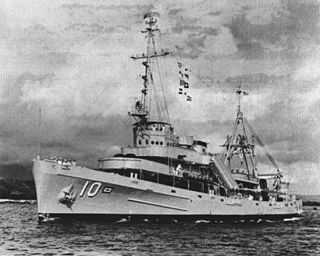
Newport News Shipbuilding (NNS), a division of Huntington Ingalls Industries, is the largest industrial employer in Virginia, and sole designer, builder and refueler of United States Navy aircraft carriers and one of two providers of U.S. Navy submarines. Founded as the Chesapeake Dry Dock and Construction Co. in 1886, Newport News Shipbuilding has built more than 800 ships, including both naval and commercial ships. Located in the city of Newport News, their facilities span more than 550 acres (2.2 km2), strategically positioned in one of the great harbors of the East Coast.
USS Nautilus may refer to:

USS Marlin (SST-2), originally USS T-2 (SST-2), was a T-1-class training submarine in commission from 1953 to 1973. She was the second submarine of the United States Navy to be named for the marlin, a large game fish. Except for the first 25 early development pre-WWI subs, she was one of the smallest operational submarines ever built for the U.S. Navy.

USS Cochino (SS-345), a Balao-class submarine, was the only ship of the United States Navy to be named for the cochino, a triggerfish found in the Atlantic. Her keel was laid down by Electric Boat Company of Groton, Connecticut. She was launched on April 20, 1945 sponsored by Mrs. M.E. Serat, and commissioned on August 25, 1945 with Commander W.A. Stevenson in command.

The Balao class was a successful design of United States Navy submarine used during World War II, and with 120 units completed, the largest class of submarines in the United States Navy. An improvement on the earlier Gato class, the boats had slight internal differences. The most significant improvement was the use of thicker, higher yield strength steel in the pressure hull skins and frames, which increased their test depth to 400 feet (120 m). Tang actually achieved a depth of 612 ft (187 m) during a test dive,
and exceeded that test depth when taking on water in the forward torpedo room while evading a destroyer.
USS Grayling has been the name of more than one United States Navy ship, and may refer to:

The New York Shipbuilding Corporation was an American shipbuilding company that operated from 1899 to 1968, ultimately completing more than 500 vessels for the U.S. Navy, the United States Merchant Marine, the United States Coast Guard, and other maritime concerns. At its peak during World War II, NYSB was the largest and most productive shipyard in the world. Its best-known vessels include the destroyer USS Reuben James (DD-245), the cruiser USS Indianapolis (CA-35), the aircraft carrier USS Kitty Hawk (CV-63), the nuclear-powered cargo ship NS Savannah, and a quartet of cargo-passenger liners nicknamed the Four Aces.

The United States' S-class submarines, often simply called S-boats, were the first class of submarines with a significant number built to United States Navy designs. Others of this class were built to contractor designs.
USS Needlefish has been the name of more than one United States Navy ship, and may refer to:
The Lake Torpedo Boat Company of Bridgeport, Connecticut was an early builder of submarines for the United States Navy in the early 20th Century.

The F-class submarines were a group of four submarines designed for the United States Navy by Electric Boat in 1909. F-1 and F-2 were built by Union Iron Works in San Francisco, while F-3 and F-4 were built by Moran Bros. in Seattle, Washington.

Battleship Memorial Park is a military history park and museum located on the western shore of Mobile Bay in Mobile, Alabama. It has a collection of notable aircraft and museum ships including the South Dakota-class battleship USS Alabama and Gato-class submarine USS Drum. USS Alabama and USS Drum are both National Historic Landmarks; the park as a whole was listed on the Alabama Register of Landmarks and Heritage prior to that time, on October 28, 1977.

The K-class submarines were a class of eight submarines of the United States Navy, serving between 1914 and 1923, including World War I. They were designed by Electric Boat and were built by other yards under subcontracts. K-1, K-2, K-5, and K-6 were built by Fore River Shipyard in Quincy, Massachusetts, K-3, K-7, and K-8 by Union Iron Works in San Francisco, and K-4 by Seattle Construction and Drydock Company in Seattle, Washington. All were decommissioned in 1923 and scrapped in 1931 to comply with the limits of the London Naval Treaty.

USS Greenlet (ASR-10) was a Chanticleer-class submarine rescue ship in the United States Navy.

Seawolf Park is a memorial to USS Seawolf (SS-197), a United States Navy Sargo-class submarine mistakenly sunk by U.S. Navy forces in 1944 during World War II. It is located on Pelican Island, just north of Galveston, Texas, in the United States.

The 4"/50 caliber gun was the standard low-angle, quick-firing gun for United States, first appearing on the monitor Arkansas and then used on "Flush Deck" destroyers through World War I and the 1920s. It was also the standard deck gun on S-class submarines, and was used to rearm numerous submarines built with 3-inch (76 mm) guns early in World War II. United States naval gun terminology indicates the gun fired a projectile 4-inch (102 mm) in diameter, and the barrel was 50 calibers long.
SSK was the United States Navy hull classification symbol for a diesel-electric submarine specialized for anti-submarine duties. SS indicated that the vessel was a submarine, and the K suffix that it was a hunter-killer. The United States Navy does not currently operate any submarines of this type, and so the designation is inactive.











